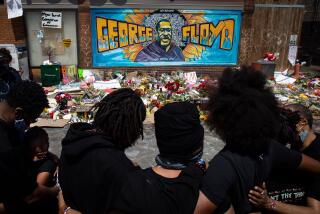TV AND THE GULF WAR : Enough of This Shoot-From-the-Lip Coverage, Already : Television: In some cases, the medium’s correspondents have become the story instead of the combatants.
- Share via
You look up, and it’s CNN talking.
“Something is incoming!”
On CNN these days, something is always incoming--whether gas masks, streaking, unidentified missiles or raw, unedited pictures that no one in the studio can figure out--even if it isn’t always news.
It is instantaneous, though, tumult right up to the millisecond. CNN and to some extent the rest of television are not merely firing from the hip, they’re launching missiles from the lip.
What is going on here? With its skittish coverage of the Persian Gulf air war, TV has become its own Scud--wildly hurtling through space, having burst through all journalistic restraints into some perilous, uncharted technological realm from which there is no return.
Vietnam may have been the first living-room war, but this war is the first one to become a small-screen, flying-by-your-seat spectacular, a regular honest-to-goodness show on TV starring TV, with CNN even accompanying its blazing “War in the Gulf” title with thundering drums.
Great war correspondents of yesteryear were known for skillfully shaping stories, while TV’s war correspondents of today are known for being their stories. Fresh from their adventures in Baghdad, for example, CNN’s Bernard Shaw and John Holliman were interviewed by CNN’s David French, then for an hour on CNN by Larry King, and on Wednesday are scheduled to be interviewed by the nation’s press on a coast-to-coast conference call. Enough already!
Never has a war produced less real news and more news stars: It’s 8:30 p.m. Monday and CNN has again flashed live to Saudi Arabia, where correspondents Carl Rochelle, in a helmet, and Charles Jaco, clutching a gas mask, are trying to talk over wailing sirens. Suddenly, Jaco jerks on his mask, then removes it. “I thought I caught a whiff of something,” he said, sheepishly, as Rochelle comforted him.
Is this wild or what? The United States has nearly 500,000 troops in the gulf region, and the only people you see in jeopardy are reporters.
What is going on here? We may not know until the sand settles and the last round is fired. But deep in your bones, you know a media line has been crossed--and it isn’t good.
Cut to Saudi Arabia for another of those alerts, and on the screen telling us what’s happening is a young guy in a gas mask you’ve never seen before. That’s because he’s not a reporter, but a cameraman/editor, swiftly pressed into service in place of the unavailable Jaco. In this speedy milieu, he’s now a foreign correspondent.
How fast is CNN? So fast that it’s having an out-of-body experience, with one of its bodies racing ahead of the other. On Sunday afternoon, anchor Lou Waters told viewers CNN was cutting to Riyadh, Saudi Arabia. Suddenly on the screen was Lyanne Melendez. She began reporting. Waters paused, then said: “You’re in eastern Saudi Arabia, you’re not in Riyadh.” Melendez continued reporting anyway, until Waters cut her off, saying: “We’re a little confused here.”
They’re confused!
On Monday, CNN was at it again, reporting sirens in Bahrain, then reporting sirens in Saudi Arabia,, then saying the sirens were only in Bahrain, then saying there aren’t sirens in Bahrain or Saudi Arabia.
CNN’s Atlanta control room is where there should be sirens.
From CNN anchor Mary Anne Loughlin on Monday: “This is from Iraq TV. It appears to be twisted metal. It’s difficult to say what we’re looking at.” Pardon me? If no one knows what it is, then maybe, just maybe, it shouldn’t be shown.
On all the networks, there have been enough speed-induced miscalls to last a lifetime, the irony being that all of this knee-jerk TV guessing may be playing right into the hands of the Pentagon.
Now it can say that its straitjacket on war coverage has already been justified by television’s performance to date.
More to Read
The biggest entertainment stories
Get our big stories about Hollywood, film, television, music, arts, culture and more right in your inbox as soon as they publish.
You may occasionally receive promotional content from the Los Angeles Times.










